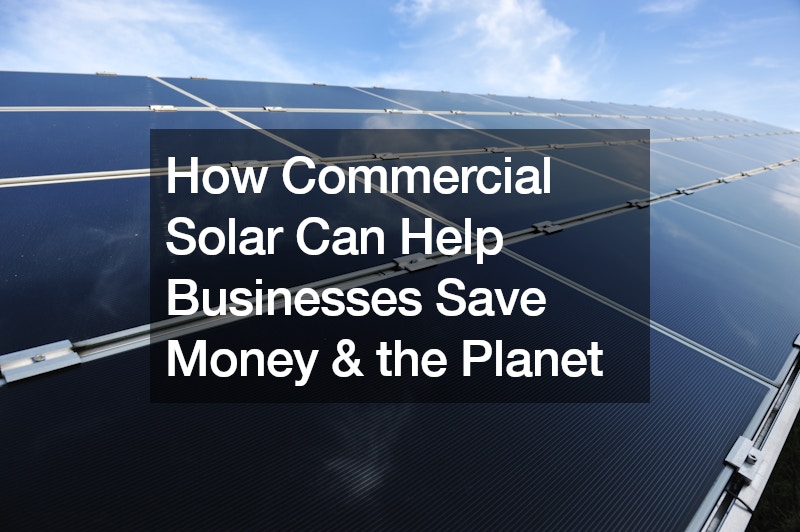Modern businesses are constantly searching for ways to reduce operating costs and improve their environmental footprint. One effective solution that addresses both concerns is commercial solar power. This sustainable energy source not only cuts down on electricity bills but also contributes significantly to reducing carbon emissions. Here’s how commercial solar works, the financial benefits it offers, and the various financing options available to businesses.
Understanding Commercial Solar Power
Commercial solar power systems typically involve installing a solar array on the business property. Solar arrays are mostly installed on roofs, requiring businesses to collaborate with commercial roofing contractors to ensure the roofs can support the solar arrays and optimize energy production. These arrays consist of photovoltaic (PV) panels that convert sunlight into electricity.
The process is straightforward: when the sun’s rays hit the PV panels, they generate direct current (DC) electricity, which is then converted into alternating current (AC) electricity via an inverter. This AC electricity is used to power the building’s operations.
Any excess electricity generated by the solar array is sent back to the electrical grid. Through a process called net metering, businesses receive credits for this excess power, effectively making their electric meters run backward. This reduces electricity costs and provides a consistent power supply by offsetting energy usage during times when solar production is lower.
Financial Benefits of Commercial Solar
1. Cost Savings
The primary financial benefit of commercial solar power is the reduction in electricity bills. By generating their own electricity, businesses can significantly lower their reliance on the grid and thus their energy costs. Besides, the concept of net metering means that any excess power produced is credited back to the business, further reducing utility expenses.
2. Tax Incentives
One of the most attractive aspects of investing in commercial solar is the array of tax incentives available. The Federal Investment Tax Credit (ITC) allows businesses to deduct a significant portion of their solar installation costs from their federal taxes. As of recent legislation, this credit covers 26% of the total system cost, providing a substantial reduction in the initial investment.
3. Depreciation Benefits
Commercial solar installations are eligible for 100% bonus accelerated depreciation. This means businesses can depreciate the entire cost of the solar system in the first year, offering a considerable tax advantage. Depreciation reduces taxable income, which can lead to significant savings on federal taxes.
4. State and Local Incentives
Apart from federal incentives, many states, municipalities, and utility companies offer their own rebates and incentives for solar projects. These can include direct rebates, performance-based incentives, and renewable energy certificates. For instance, businesses can sell Solar Renewable Energy Certificates (SRECs) generated by their systems. SRECs represent the environmental benefits of generating solar power and can be sold to utilities, creating an additional revenue stream.
Financing Options for Commercial Solar
1. Power Purchase Agreements (PPAs)
A popular way to finance a commercial solar system is through a Power Purchase Agreement (PPA). In this arrangement, a solar developer designs, finances, and installs the solar system on the business property at no upfront cost. The business then purchases the electricity generated by the system at a lower rate than it would pay the utility, resulting in immediate savings. PPAs also transfer the risk of ownership and maintenance to the developer, making it a hassle-free option for businesses.
2. Operating Leases
An operating lease allows businesses to lease the solar equipment for a fixed period. This works similarly to leasing other types of equipment and is straightforward for most business owners to understand. The main difference between an operating lease and a PPA is that with a lease, the business is paying for the equipment itself, while with a PPA, it is paying for the electricity produced by the equipment. At the end of the lease term, businesses usually have the option to purchase the system at a reduced price.
3. Loans
Another financing option is obtaining a solar loan. Many financial institutions offer loans specifically designed for solar energy projects. These loans can cover the cost of the system and are paid back over time. Solar loans often have favorable terms and interest rates, making them an attractive option for businesses that prefer to own their solar systems outright.
4. Environmental Impact
Beyond the financial benefits, commercial solar power plays a signifcant role in environmental sustainability. Businesses reduce their dependence on fossil fuels by making the switch to solar energy, ultimately lowering their carbon footprint. Solar energy is a clean, renewable resource that helps decrease greenhouse gas emissions and combat climate change. For businesses committed to corporate social responsibility, investing in solar power is a tangible way to demonstrate their commitment to sustainability.
In Closing
Commercial solar offers benefits that go well beyond merely reducing energy expenses. It offers substantial financial benefits through tax incentives, depreciation, and potential revenue from selling renewable energy certificates. Various financing options, such as PPAs, operating leases, and loans, make it accessible to a wide range of businesses. Plus, the environmental benefits of reducing carbon emissions and reliance on fossil fuels make commercial solar an excellent choice for businesses looking to make a positive impact on the planet. The combined financial and environmental advantages make commercial solar a powerful solution for forward-thinking businesses.
.


